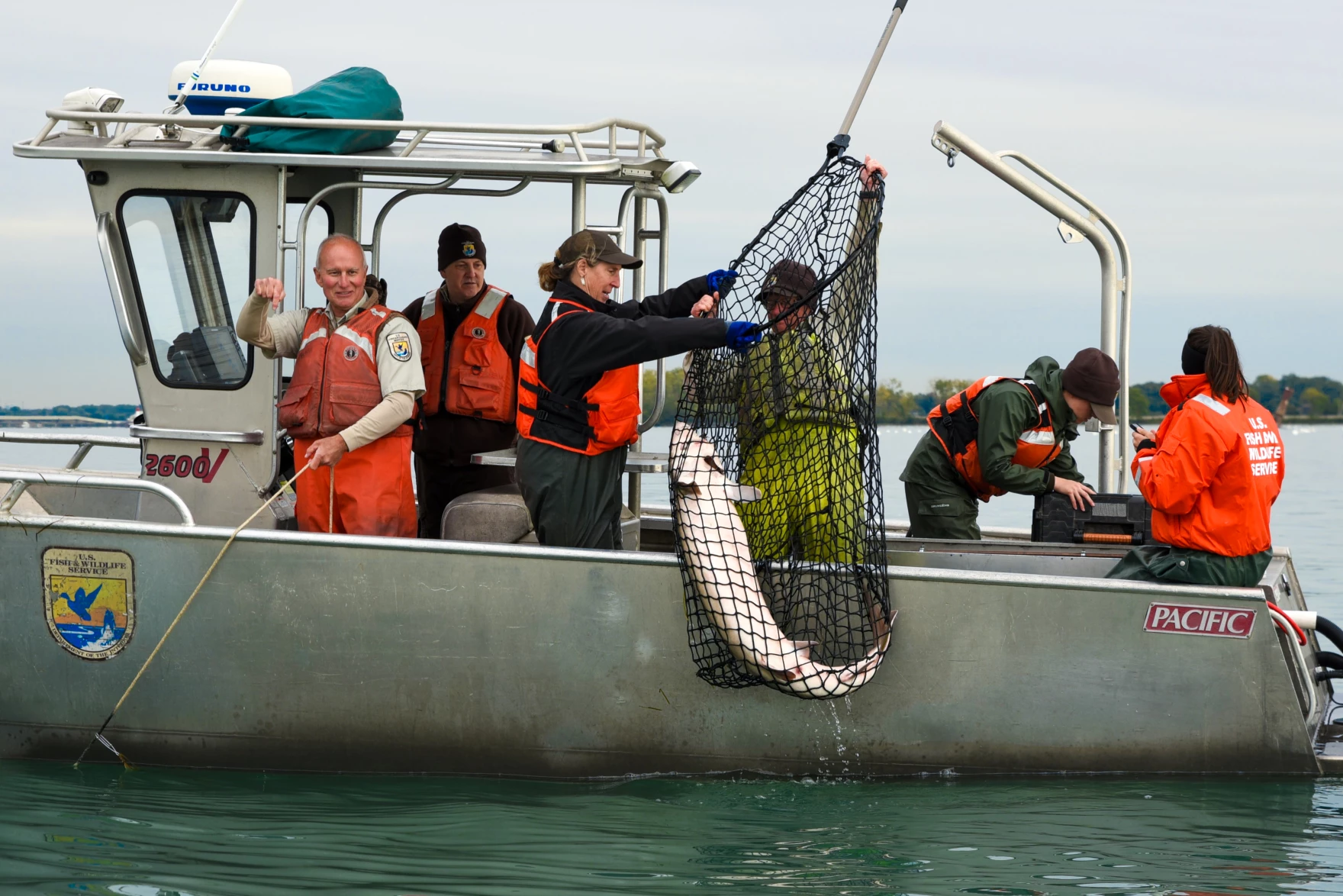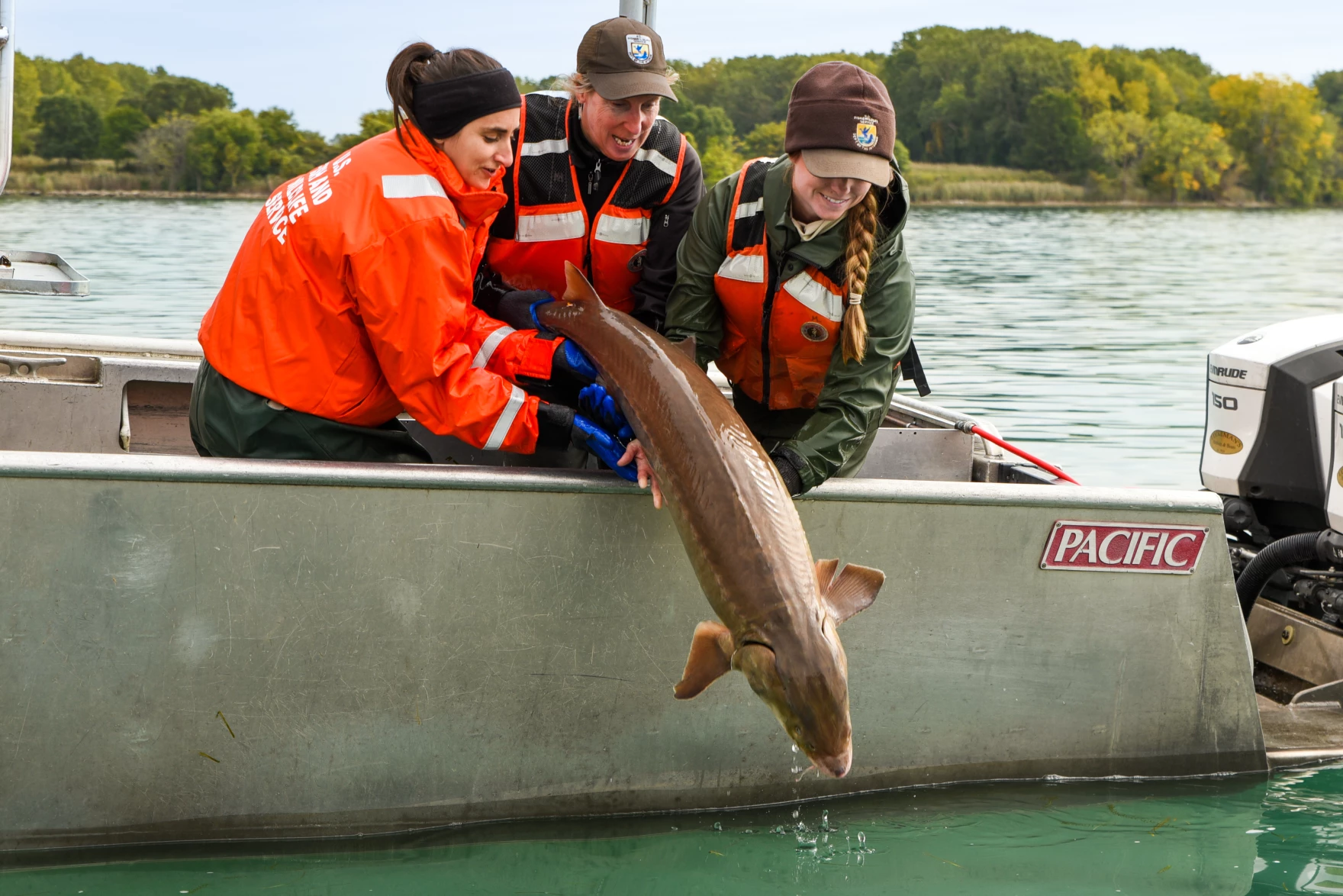
By Lester Graham, Michigan Radio
The Great Lakes News Collaborative includes Bridge Michigan; Circle of Blue; Great Lakes Now at Detroit Public Television; and Michigan Radio, Michigan’s NPR News Leader; who work together to bring audiences news and information about the impact of climate change, pollution, and aging infrastructure on the Great Lakes and drinking water. This independent journalism is supported by the Charles Stewart Mott Foundation. Find all the work HERE.
- Five decades ago the Cuyahoga was a symbol of all that was wrong with the environment. Now it’s believed to be clean enough for the ancient fish.
- Fertilized sturgeon eggs from the upper St. Clair River near Port Huron are sent to a Wisconsin hatchery and then those fish will populate the Ohio river.
The number of an ancient fish in the Great Lakes is growing and being re-introduced to rivers where it has not been seen in 100 years or more.
Lake sturgeon have been released into rivers in Michigan and Ohio. It will be 15 years or more to know whether the fish will return to spawn because they don’t mature sexually until that age or older.
Since the 1990s the U.S. Fish and Wildlife Service has been coordinating an effort to revive the population in the Great Lakes.
“You know, it’s like a 50-year plan because these fish don’t reach maturity sometimes until 15 years or something like that. So you can’t expect results right away. It’s a long process,” said Jesse McCarter, a Fish and Wildlife Service fish biologist on another project. He’s keeps up with his colleagues’ work to repopulate the sturgeon.
“When we embark on this, it’s a huge investment. It spans the careers of people,” said Jim Boase who leads the team working with lake sturgeon. He’s been researching sturgeon his entire career.
A large number of sturgeon come together to breed where Lake Huron flows into the St. Clair River, at Port Huron, Michigan.
They’ve been using that brood stock to reproduce more sturgeon. After fish eggs are fertilized, they’re sent to the Genoa National Hatchery in Wisconsin. Eventually they’ll be released in a river. The sturgeon will likely return there when their mating instincts finally kick in.
In the Detroit River there’s another sizeable population of sturgeon. The Director of the U.S. Fish and Wildlife Service, Martha Williams has been visiting wildlife refuges. When she got the Detroit International Wildlife Refuge, Jim Boase recruited her to work on this boat catching sturgeon.
“Oh, I didn’t know I was going to pick it up. I thought it was strong and I was overwhelmed. So cool,” Williams said later.

Martha Williams, Director of the U.S. Fish and Wildlife Service (on the right) was recruited to help catch and examine lake sturgeon. (Photo Credit: Lester Graham/Michigan Radio)
She helped fish biologist and lead researcher Justin Chiotti drag in a 67-pound sturgeon from the river into the boat. There, it was measured, weighed, a chip was inserted (the kind you might put in your pet), and small tissue sample was taken for DNA testing.
Williams has been touring different wildlife refuges this year… which is the 50th anniversary of the Endangered Species Act. When asked about the decline in populations of birds, bats, and other wildlife, she said population drop of so many species around the world and in the U.S. greatly concerns her.
“But I am also hopeful. Days like today remind me of that, that when we do invest in nature, it has this incredible ability to rebound,” she said.
She added that investments such as the Bipartisan Infrastructure Act and the continuing funding of the Great Lakes Restoration Initiative are making a difference.
The stretch from Lake Huron at the St. Clair River down to where the Detroit River enters Lake Erie, has more than 33,000 sturgeon, according to a study by Justin Chiotti and other scientists. Their progeny have repopulated the Saginaw River basin which includes the Flint, Cass, Shiawassee, and the Tittabawassee rivers.
The Fish and Wildlife Service worked with the Toledo Zoo to restore sturgeon to the Maumee River in just the last few years.

Releasing the lake sturgeon after it’s been chipped, clipped (a bit of fin for DNA analysis), weighed, and measured. (Photo Credit: Lester Graham/Michigan Radio)
“The next river that we’re shooting for is the Cuyahoga. And so now I’m letting it out to the whole public here,” Boase laughed.
It’s very symbolic because of the history of the Cuyahoga River at Cleveland. Industrial dumping in the river led to occasional fires.
A fire in 1969 ended up being a story in Time magazine. Newspapers across the country picked up the story. That event along with a large oil spill and the release of Rachel Carson’s book, Silent Spring caused public outrage. Congress passed a series of laws, including the Clean Water Act and the Endangered Species Act.
President Richard Nixon proposed an agency to coordinate the efforts. The Environmental Protection Agency was founded.
To see lake sturgeon introduced into the Cuyahoga River just a little more than five decades later is significant.
“Absolutely right,” said Jim Boase, adding, “And it is a bit serendipitous for me to be at the tail end of my career and hopefully, you know, as I tell staff, I’m like, that’ll be my mic drop moment.”

U.S. Fish and Wildlife Service Director Martha Williams assists Justin Chiotti in getting a 67 pound lake sturgeon onto the boat. Jim Boase, holding a line to the left of them is pointing down into the water where another fish has been caught. (Photo Credit: Lester Graham/Michigan Radio)
Boase is also eyeing rivers on the Canadian side of the border.
The sturgeon is becoming –or maybe already has become- a poster child example of Great Lakes recovery.
As the sturgeon repopulation effort has grown, so has public awareness. And a lot of people have embraced the ancient fish as a symbol.
(You can learn more about Boase and Chiotti’s work here.)
Although, up close, there’s sometimes some hesitancy. It does not look like other fish in the Great Lakes. It doesn’t have scales. Instead is has a sort of armored plating. It doesn’t have bones, but instead cartilage, like a shark.
Jesse McCarter was involved with a partnership between the Fish and Wildlife Service and the Youth Conservation Corps. He’d take high school students or those who recently graduated out in a boat to set lines with different types of gear to catch fish.
“And the first time that we brought up one of these sturgeon, the kids, I mean, they thought it was like a shark. They’re like, ‘What is that thing?’ Some of them were afraid of it at first.”
After the kids got to hold one, McCarter said they thought sturgeon were “awesome.”
Catch more news at Great Lakes Now:
New federal money is the start of an effort to make Great Lakes coasts more resilient
Featured image: U.S. Fish and Wildlife Service Director Martha Williams assists Justin Chiotti in getting a 67 pound lake sturgeon onto the boat. Jim Boase, holding a line to the left of them is pointing down into the water where another fish has been caught. (Photo Credit: Lester Graham/Michigan Radio)




